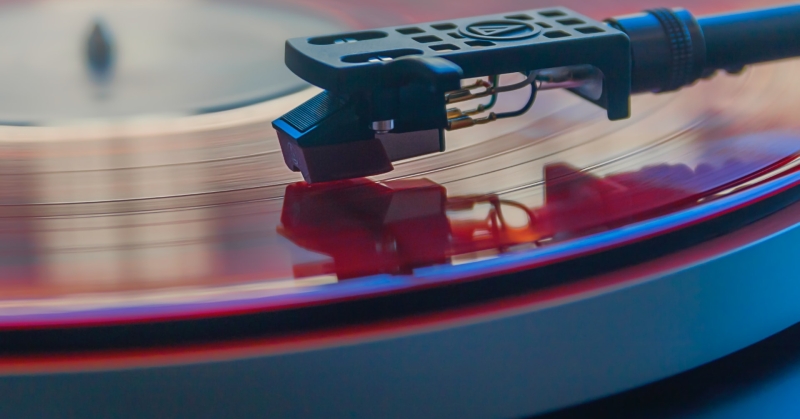Prior to Thomas Edison's invention of the phonograph in 1877, the only method for people to absorb music was to attend a live concert. The phonograph was the first machine to record and play music, and it used special cylinders, a playback stylus, a diaphragm, and a horn to do it. Edison introduced pre-recorded cylinders a few years later in 1889, thereby allowing music to be delivered in large quantities.

The introduction of flat-disc recordings in the late 1890s, which came in several sizes – five-inch, 10-inch, and 12-inch – marked the beginning of vinyl. Shellac flat-discs were used at the time, and vinyl wasn't introduced until after World War II. A 12-inch vinyl record could hold around 20 minutes of music on each side, allowing for significantly more music to be recorded into a single disc. Aside from the records themselves, music-playing technology has progressed as well. Music could be distributed more simply thanks to belt and direct-drive turntables, as well as gadgets like more modern style.
The RCA tape cartridge was first introduced in 1958. The RCA was the first medium to employ a magnetic tape to store significant volumes of music for home use, and it was a forerunner to the cassette tape. This meant that a considerably smaller gadget could now store up to 60 minutes of music. Soon after, 8-track tapes and 8-track devices were created, allowing music to be played in automobiles. Music was now available not only at home but also anywhere four wheels could carry you. The Walkman, invented by Sony in 1979, took music mobility to a new level. This little portable stereo tape player permanently transformed the face of music consumption: music fans could now take their sounds wherever they went.
The CD Age
Music was recorded on compact CDs in the 1980s. CDs emerged into the music scene due to their ability to hold even more music and for opening the way for CD-RW (rewritable CDs). Until the introduction of mp3s and electronically-encoded music, they remained largely unquestioned as the standard music storage media. This increase would go on to fundamentally alter the music business as it was at the time. Mp3s allowed music to be illegally shared via peer-to-peer music services like Napster.
Streaming services
With the emergence of Pandora, legal streaming really took off. A service that allowed audiophiles to listen to thousands of songs without purchasing an album was a tough sell. However, this did not prevent other music streaming businesses from following suit. Spotify is the most popular, but there are a slew of other options, including iHeartRadio and iTunes Radio.
These services have dominated the music industry, surpassing digital music sales entirely. While musicians may not receive the same royalties as in the past, these services have opened up the market to a new generation of artists who would not otherwise have had the opportunity or platform to be noticed.
The music business has consistently adopted forward-thinking technical innovations over the last few decades. The market has altered dramatically as a result of the growth of digitisation, with groundbreaking notions ushering music into a new era. Few would disagree that listening to albums and singles is easier than it has ever been.
The music industry's quick transition is a typical illustration of how a single breakthrough may disrupt an entire sector and render traditional industry expertise outdated. The capacity to control physical distribution was a big part of the pre-Internet music industry's power and influence. Physical music distribution is becoming increasingly obsolete as a result of the internet, and the large music corporations have been forced to reinvent themselves in order to survive.
While the digital music revolution undoubtedly harmed music industry behemoths in terms of sales, it also leveled the playing field between large and small music companies, such as independent record labels.
Musicians may now record at a minimal cost thanks to advancements in home recording software. Artists and small labels can also bypass bigger industry-controlled distribution channels by using digital distribution platforms.
Artists may communicate with followers directly through social media and video streaming platforms, decreasing the need for costly public relations initiatives. In general, the digital era has resulted in a democratization of the music business, which has improved chances for a wide range of artists and professionals.
A lot of current music is made with the help of cutting-edge music technology. Virtual instruments and MIDI technology enable artists to employ millions of sounds in their music composition, which they may program and control in various ways. For the tech-savvy composer or producer, this opens up a lot of creative possibilities.
To compensate for decreased sales, musicians and music firms have forced to diversify revenue streams in novel ways. For artists, audio engineers, venues, promoters, and other professionals, the live music industry has long been a significant source of revenue. As the digital revolution destroyed record sales, many professionals in the music industry began to focus more on live music.
Live music has been steadily growing throughout the previous two decades before COVID-19. During the epidemic, musicians used donation links or paid access services to monetize livestreamed concerts on social media sites.
The digital era has been difficult for the music industry, but it has also provided opportunities for new performers who would not otherwise have received the recognition they deserve. This democratization and expansion of music through technology, as well as the ability to see a performance live online from thousands of kilometers away, is a benefit for music fans. Music technological advancements have sparked development and creativity in music creation, which is, after all, what art is all about.























